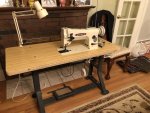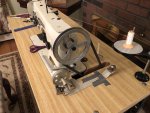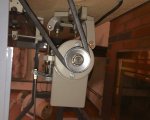To summarize, I thought that I would share my findings, having done a search for machines that would be capable of (and good for ) vinyl upholstery & canvas work.
I got the Consew 206RB-4 for $500

which is a really good price (IMO). the machine I got was purchased originally in 2003, so it is 15+ years old. Still seems to be in good shape . . . needed some oiling, which I took care of.
For anyone looking at a machine for this kind of work, I'd highly recommend a machine that has 'walking foot' & 'needle feed' (aka 'compound feed'). they will cost a bit more in the used market, but I think the resulting stitch quality will be sooo much better.
In terms of brands & models with walking foot/compound feed that seem to be on the used market, I found these:
Consew
225
226
206RB
Juki
1508
1541
Singer
111
211
Highlead
GC0618-1-SC
Chandler/Adler
67
167
Sailrite
111
'Fabricator' (which is a newer version of the 111)
I did find some machines that had a walking foot, BUT were not needle feed. Therefore you are relying on the top & bottom 'feet' of the machine to move the material through the machine. While this is much better than a regular feed machine, which only pulls the material from the bottom, it is not as good as having the needle itself be part of the feeding mechanism.
Also, I would stay away from the 'portable' machines, since they do not have needle/compound feed. The portable machines tend to have a mechanism that moves the presser feet to provide a top feed in addition to the regular bottom feed. They'd be good for some canvas repair work or very simple upholstery work, but still not up to the capabilities of an industrial machine with walking foot & compound feed.
I also found many 'knock-off' models in the portable machines, similar to the Sailrite LS1 series, but with (supposedly) cheaper parts. The reviews I found on these types of machines were fairly mixed.
Finally, the sewing world is being taken over by 'servo motors' . . . the prior standard was to have a 'clutch' motor. The difference being that the clutch motor is always spinning at its top RPM while you have the machine 'on' and you engage the 'clutch' with a foot pedal, similar to the clutch in a car (manual transmission that is . . .). While the clutch initially engages slowly, it tends to 'grab' after a second or 2 and before you know it, your sewing machine is running at full speed, which is about 15-20+ stitches per second

In most cases this is too fast for detail work, like small pieces, corners, etc.
Servo motors use modern electronics and position/speed sensing to regulate the speed of the motor, giving you much more control over the machine speed. When doing vinyl upholstery & canvas work, I think most people will want a slow machine speed and one that they can significantly control. Servo motors will do this vs. a clutch motor.
I have a servo motor on order for my Consew 206RB-4. Many models of servo motors will be interchangeable with a clutch motor from a mounting perspective. So, the swap-out should be fairly easy.
Anyway, I am really psyched about my 'new' sewing machine. I'm not a sewer by any means, but the machine seems to produce excellent work, even with a rookie like me at the controls

:thumb:
)























